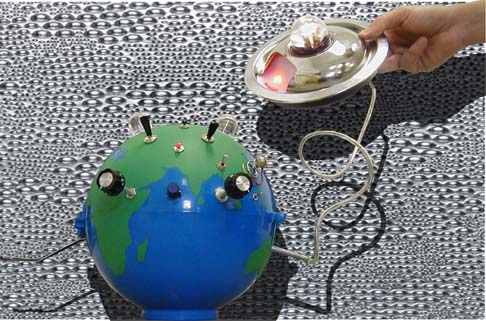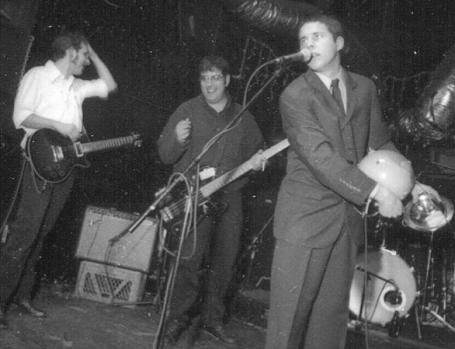
Built by Mike Walters, 2001
Back
to Mystery Circuits Projects

Like many people, I got really excited when I heard about Circuit Bending. I was pretty new to electronics, and this artform seemed perfect for what I was getting interested in. The next day, I drove to an antiques shop in Pittsboro called Beggers and Choosers. There wasn't much in the way of electronic toys, but I bought everything they had that made noise and ran on batteries. I also ended up with this really cool plastic lunchbox/container thing that was shaped like a globe, and had a handle on the top.
So I opened up all these little crib toys, and this little circa 70s game thing that I found out was for the board game Stop Theif. That was the device that got me hooked on bending circuits. I had already built little dual-555 oscillator photo theremin circuit, and I crossed it with the Stop Theif circuit. Anyway, I crammed it all into the globe, and played it with a flashlight. That gave me the idea of adding the flying saucer light to it. I called it "Globotron! The Electronic Earthball!"
Not long after that, I started this website and put Globotron on there first. I've redone the sound sample, but here's the description that's always been on the site since its completion. As you can see, I was pretty excited about life:
Globotron! The Electronic Earthball! was my first "Circuit Bend." The sounds are the best! Basically, it's the Earth with an attached flying saucer, and it makes both random and controlled noises almost like an Atari. The Earth I used was a plastic globe/lunchbox, and I put several knobs, switches, buttons, light sensors, and a spring atop the surface. I built the flying saucer out of chrome stove pieces, an ashtray, and clear capsule from one of those quarter toy machines from the grocery store. It has lights on it, and is wired to the globe through a medical tube. The power up is a three step process. Switch one powers all the lights. Switch two starts the photo-theremin. Finally, when the spring is pushed, the unit is in full operation. When playing it, noises appear constant, and can be controlled with the knobs and switches. The buttons produce random preset noise effects that I used from an old electronic game circuit. The whole sound that is produced is then affected by the light sensors that get their light by waving the light from the flying saucer over them (kind of like a bow on a violin...). It has lights on the front of the globe that blink; a red and a green one, and then a yellow one respectfully placed on the RTP.

Mike Walters singing a song about Globotron at one of
the first Jett Rink gigs
Photo by Alex Maness 2001
